

A printed reproduction
of a two-dimensional work of art should not be
called a poster unless it's intended to be an advertisement.
Examples of posters:
Listed chronologically by artist's birth year
Use ctrl-F (PC) or command-F (Mac) to search for a name

Nathaniel Currier (American, 1813-1888),
Grand
National Democratic Banner, 1844, hand-colored
lithograph, 11 3/4 x 8 3/8
inches, National Portrait Gallery, Washington, DC. Promoting James K. Polk for president, George M. Dallas for vice-president.

Louis
John Rhead (American, 1857-1926) for The New York Sun,
Read the Sun, 1895, color lithograph,
46 13/16 x 29 inches (118.9 x 73.7 cm), Metropolitan Museum of
Art, NY.
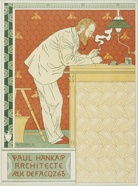
Adolphe Crespin (Belgium, 1859-1944),
Poster for ’Paul Hankar, Architect’, 1897, color lithograph, 15 1/2 x 11 1/8 inches (40 x 29 cm), Los Angeles County Museum of Art. See architect and pattern.

Théophile Alexandre Steinlen (French,
1859-1923), Chat Noir, color lithograph, a poster advertising an event at the Chat
Noir, a Paris cabaret from 1881 to 1897. See Art Nouveau.
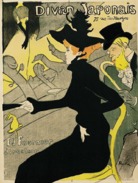
Henri de Toulouse-Lautrec (French, 1864-1901),
Divan Japonais, 1893, color lithograph,
complete: 31 5/8 x 23 7/8 inches (80.3 x 60.7 cm), Museum of
Modern Art, NY. This poster advertises a cabaret in Montmartre,
Paris. In the center sits the famous cancan dancer Jane Avril,
whose elegant black silhouette
dominates the scene. Lithographed posters proliferated during
the 1890s due to technical advances in color printing and the
relaxation of laws restricting the placement of posters. Dance halls, café-concerts,
and festive street life invigorated nighttime activities. Toulouse-Lautrec's
brilliant posters, made as advertisements, captured the vibrant
appeal of the prosperous Belle Époque. See Art Nouveau, and a page about Toulouse-Lautrec
and Post-Impressionism.
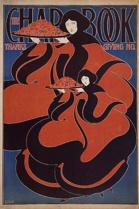
William H. Bradley (American, 1868-1962)
for Stone & Kimball (Chicago), The Chap Book: Thanksgiving Number, 1895,
color lithograph, 19 5/8 x 18 7/8
inches (49.9 x 33.8 cm), Baltimore Museum of Art. See Art Nouveau.

William H. Bradley, Narcoti Chemical Co.
(Springfield, Massachusetts), Narcoti-Cure, 1895, color lithograph,
20 x 13 1/2 inches (50 x 34 cm), Baltimore Museum of Art. The
product advertised here was
promoted as a cure for the cigarette smoking habit, although
the curative value of using a narcotic to do it remains suspect.

Maxfield Parrish (American, 1870-1966) for
The Century Co. (New York), printed by the Thomas & Wylie
Lithographic Co., The Century Midsummer Holiday Number,
1897, color
lithograph, 47.1 x 30.6
cm (18 9/16 x 12 inches), Delaware Art Museum.
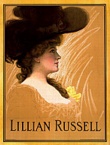
Strobridge Lithography Company (American),
Lillian
Russell (American actress, 1861-1922), c. 1900, chromolithograph,
National Portrait Gallery, Washington, DC.

Ludwig Hohlwein (German) designer, Zoologischer
Garten München, 1912, lithograph,
49 1/4 x 35 3/8 inches, (125.1 x 89.9 cm), Museum of Modern Art,
NY.
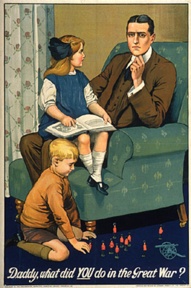
Savile Lumley (British, 20th century), Daddy What Did You Do in the Great War? about 1915, lithograph, Hood Museum of Art, Dartmouth College, NH.

James Montgomery Flagg (American, 1877-1960),
I Want You for U.S. Army, 1917, chromolithograph,
39 1/2 x 29 1/8 inches (100.4 x 73.8 cm), National Museum of
American Art. Flagg's version of Uncle Sam is a self-portrait. Used for recruitment
during World War I and again during World War II, his popular
poster demonstrates the commanding effectiveness of a strong
design and simple message. See
icon and illustration.
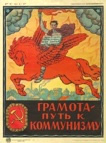
Russian, Literacy is the path to communism, 1920, Gosizdat, publisher, Moscow, lithographed poster, 72 x 54 cm. See propaganda and Russian art.

A. M. Cassandre [pseudonym of Adolphe Jean-Marie
Mouron] (born in the Ukraine 1901, died 1968, worked in France
and the USA), L´Intransigeant, Le plus fort,
1925, lithograph in black,
blue, red and gold inks, Kunstbibliothek, Berlin.
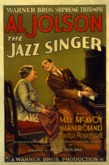
American, Warner Brothers Motion Picture
Studios, The
Jazz Singer, 1927. This poster advertises the first major "talking picture." It starred Al Jolson, and was directed
by Alan Crosland.
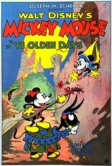
American, for Walt Disney (American, ), Joseph M. Schenck Presents Walt Disney's Mickey
Mouse in "Ye Olden Days," 1933, color lithograph,
41 x 27 inches (104.1 x 68.6 cm).
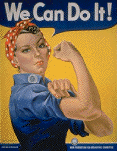
J. Howard Miller (American), for the Westinghouse
War Production Co-Ordinating Committee, We Can Do It!, c. 1942, poster.
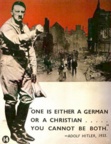
British, One is Either a German or a Christian, c. 1942-43, poster, Number 14 in a series. See propaganda.
Norman Rockwell (American, 1894-1978), Save Freedom of Speech, Buy War Bonds, 1943. A young blue-color worker stands up to express his opinion at a New England town meeting. This is one of a set of pictures Rockwell painted on the "Four Freedoms" -- freedom of speech, freedom of worship, freedom from want, and freedom from fear.
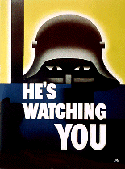
Glenn Grohe (American, 1912-1956), He`s Watching
You, c. 1942, gouache
on cardboard, poster commissioned
by USA government, National Archives and Records Administration,
Washington, DC. See propaganda.
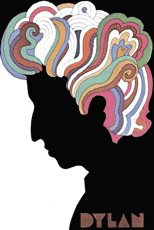
Milton Glaser (American, 1929-), Bob Dylan,
color lithograph, 1967.
Milton Glaser may be the most influential graphic designer of
our time.
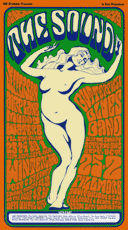
Wes Wilson (American, 1937-), West Coast
Lithograph Co. (San Francisco), Bill Graham Presents . . .
at the Fillmore Auditorium, 1966, color lithograph,
19 x 13 3/4 inches (48.3 x 34.9 cm).
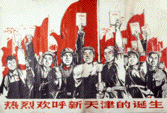
China, Masses of the People March in support of the
revolution, holding the red flag and the red book of Mao's writings,
from the People's Republic
of China's period known as the Cultural Revolution, 1966-1976,
poster, Burke Museum, U of WA, Seattle. See Chinese art.

Lorraine Schneider (American, 1925-1972), for the Los Angeles organization Another Mother for Peace (AMP), war is not healthy for children and other living things, a Vietnam
War protest poster, 1967, offset lithograph.

Art Workers Coalition, Q. And babies? A. And babies, a Vietnam
War protest poster, 1969.


TBWA Chiat/Day (American advertising agency), Apple Computers "Think different" advertising campaign, 1980s and 1990s.
Images of fourteen posters Apple distributed as part of that
campaign: Mohammed
Ali 1 and 2,
Neil
Armstrong on the Moon, Joan Baez, Maria Calas, Dalai Lama, Miles Davis, Bob Dylan, Albert Einstein, Mahatma Gandhi, Jim Hensen, Alfred Hitchcock, John Lennon and Yoko Ono, and Pablo Picasso 1 and 2. See different.
Fallon McElligott, The one on the left will finish high school before the one on the right, Children's Defense Fund poster, 1984.
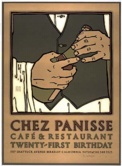
David Lance Goines (American, 1945-), Chez Panisse Café & Restaurant,
Twenty-First Birthday, 1992, photo-offset lithograph, 60.9 x
44.4 cm (24 x 17 1/2 inches), Smithsonian American Art Museum,
gift of the artist.

Coalition For The Homeless, How Can You Worship A Homeless Man On Sunday And Ignore One On Monday?, offset lithograph, 1990s?, New York, NY.
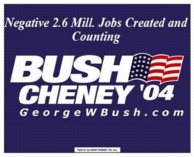
American, Bush-Cheney Campaign Poster: Negative 2.6 Million
Jobs Created and Counting, 2004. This is a satirical poster produced by an opponent to President George W. Bush. The unnamed
designer was a visitor to the White House Web site who added the text at the top by using the "Sloganator" software posted there (but no longer). See subliminal
message.

Huanwu Zhai (American, contemporary), What will you remember most about turning 18?, 2004, poster. Click on the title to download an 11 x 17 inch PDF file. You'll need Adobe's free Acrobat Reader software to open and read this file. If you don't have it, download it by clicking here. This poster is one of numerous "get out the vote" posters designed by members of AIGA. The fraction of registered 18-24 year old American voters who actually voted in the November 2004 election was 25%. If 50% had voted, George W. Bush would not have been elected to a second term. See tattoo.
Also see ephemera, fluorescent colors, graphic arts, graphic design, illustration, illustrator, memorabilia, and propaganda.
https://inform.quest/_art
Copyright © 1996-![]()